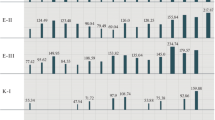Abstract
A factor causing dark pigmentation of the abdomen in females ofD. melanogaster has been located on the third chromosome, at locus69,8±0,4 morgans.
Among 19,050 flies no crossing over was found to occur between this factor (derived from a wild population) and the geneebony. These results and those of segregation experiments point toward an allelism of the dark factor withebony. For the dark factor the symbole ug is used.
The compounde ug /e is phenotypically indistinguishable from dark individuals of genotypee ug/e ug.
In 12 mass cultures, thee ug allele formed a balanced polymorphism with the wild type allele. Up to the end of the experiments lasting eight months, the heterozygotes (e ug/+) were present in excess. The frequencies ofe ug/e ug-flies sank to the lowest value in the course of 8 weeks and thereafter remained (after a brief rise) at an almost constant level. In no case dide ug disappear from the populations. Varying experimental temperatures (20°, 25°, 28°C) had no effect whatever upon the selective processes, with the exception of an increase of dark females at 20°C.
The imagos of genotypese ug/e ug,e ug/+ and +/+ were compared with reference to fecundity, hatchability, viability of larvae and pupae, drought resistance, imaginal age attained, and sterility. The homozygous dark animals consistently show reduced vitality. Regarding fecundity, drought resistance, and imaginal age attained, heterosis effects could be demonstrated. The balanced polymorphism is explained by the relatively higher fitness of the heterozygotes.
Similar content being viewed by others
Literatur
Alexander, M. L., (1953). Mutation rates at specific autosomal loci in the mature and immature germ cells ofD. melanogaster.Genetics 39: 409–428.
Bridges, C. B. & K. Brehme (1944). The mutants ofDrosophila melanogaster. Carnegie Inst. of Wash. Publ. No. 552, 252 pp.
Bridges, C. B. & T. H. Morgan (1923). The third-chromosome group, of mutant characters ofDrosophila melanogaster. Carnegie Inst. of Wash. Publ. No. 327, 249 pp.
Burla, H. (1954). Distinction, between four species of themelanogaster-group,D. séguyi, D. montium, D. kikkawai andD. auraria.Rev. Brasil., Biol. 14: 41–54.
Buzzati-Traverso A. A. (1952). Heterosis in population genetics. Heterosis ed. by John W. Gowen. Jowa State college press, chapter 9: 149–160.
Buzzati-Traverso, A. A. (1955). Evolutionary changes in components of fitness and other polygenic traits inDrosophila melanogaster populations.Heredity 9: 153–186.
Da Cunha, A. B. (1946). Polymorphism in natural populations of a species ofDrosophila.Journ. of Heredity 37: 253–256.
Da Cunha, A. B. (1949). Genetic analysis of the polymorphism of color pattern inDrosophila polymorpha.Evolution 3: 239–251.
Freire-Maia, N. (1953). Frequencies of the two color forms, of the BrazilianD. montium in natural populations.Drosophila Information Service 27: 90–91.
Freire-Maia, N. (1954). TheHardy-Weinberg law in Brazilian natural populations ofD. kikkawai.Drosophila Information Service 28: 119–120.
Freire-Maia, N. &A. Freire-Maia (1955). Race differentiation in a domestic species,-the case ofD. kikkawai.Drosophila Information Service 29: 118.
Glass, H. B. (1939).ebony 39g Drosophila Information Service 12: 47.
Greuter, M. (1963). Vergleich der Ausbreitungsaktivitäten vonDrosophila subobscura undDrosophila obscura, Diss., im Druck.
Hadorn, E. &H. Zeller (1943). Fertilitätsstudien anDrosophila melanogaster.Wilhelm roux' Arch. für Entwicklungsmechanik 142: 276–300.
Hexter, W. M. (1955). A population analysis of heterozygote frequencies inDrosophila.Genetics 40: 444–459.
Kalmus, H. (1945). Adaptative and selective responses of a population ofDrosophila melanogaster containinge ande + to differences in temperature, humidity and to selection for developmental speed.,Journal of Genetics 47: 58–63.
Mickey, G. H. (1954). Visible and lethal mutations inDrosophila.The American Naturalist 88: 241–255.
Moree, R. &J. R. King (1961). Experimental studies on relative viability inDrosophila melanogaster.Genetics 46: 1735–1752.
Moriwaki, D., T. Okada &H. Kurokowa (1952). Two types ofD. auraria.Drosophila Information Service 26: 112.
Oshima, C. (1952). Genetic analysis of the dimorphism of color pattern inD. rufa.Drosophila Information Service 26: 116.
Perttunen, V. &H. Salmi (1956a). The responses ofDrosophila melanogaster to the relative humidity of the air.Ann. Entomol. Fennici 22: 36–45.
Perttunen, V. &H. Salmi (1956b). The effect of age on the humidity reaction ofDrosophila melanogaster.Ann. Entomol. Fennici 22: 63–71.
Rosin, S. (1948). Die Anwendung der Methode des “maximum likelihood” (R. A. Fisher) bei der Genlokalisation.Arch. Julius Klaus Stiff. 23: 559–562.
Stalker, H. (1953). Taxonomy and hybridisation in thecardini-group ofDrosophila.Ann. Entomol., Soc. Amer. 46: 343–358.
Stern, C. (1926). Eine Kreuzungsanalyse von Körperfärbungen vonD. melanogaster verbunden mit drei neuen Allelomorphen des Faktors “ebenholz”.Z. ind. Abst. Vererbl. 41: 198–214.
Tantawy, A. O. &G. S. Mallah (1961). Studies on natural populations ofDrosophila. I. Heat resistance and geographical variation inDrosophila melanogaster andD. simulans.Evolution 15: 1–14.
Teissier, M. G. (1947a). Variation de la fréquence du gènesepia dans une population stationnaire de Drosophiles,C. R. Acad. sci. 224: 676–677.
Teissier, M. G. (1947b). Variation de la fréquence du gèneebony dans une population stationnaire de Drosophiles.C. R. Acad. Sci. 224: 1788–1789.
Villee, C. (1941).e st.Drosophila Information Service 14: 40.
Van der Waerden, B. L. (1957). Mathematische Statistik. Berlin, Springer-Verlag. 360 pp.
Wilson, R. E. (1921). Humidity control by means of sulfuric acid and solutions with critical compilation, of vapor pressure data.J. of Industr. and Engin. Chemistry 13: 326.
Young, W. C. &H. H. Plough (1926). On the sterilisation ofDrosophila by high temperature.Biol. Bulletin Woods Hole 51: 189–198.
Zürcher, C. (1958). Ein Farbpolymorphismus beiDrosophila melanogaster.Arch. Jul. Klaus Stiff. 33: 75–82.
Zürcher, C. (1960). A factor for dark abdomen present in a wild strain ofD. melanogaster.Drosophila Information Service 34: 112.
Author information
Authors and Affiliations
Rights and permissions
About this article
Cite this article
Zürcher, C. Der Faktore ug beiDrosophila Melanogaster: Lokalisation, Frequenzänderungen in Massenzuchten und Lebensleistungen Seiner Träger im Vergleich mit einem Wildstamm. Genetica 34, 1–33 (1964). https://doi.org/10.1007/BF01664176
Received:
Issue Date:
DOI: https://doi.org/10.1007/BF01664176




